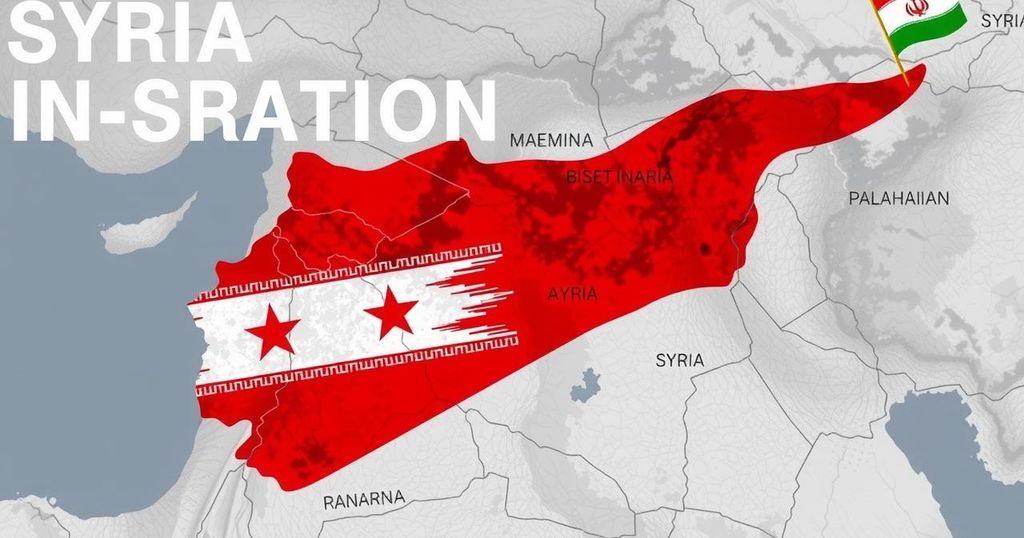Recent military offensives against the Assad regime have led to the abandonment of the Iranian proxy groups, Fatemiyoun and Zainebiyoun, raising concerns over their future. Historically significant in battles against IS, these brigades are unlikely to be disbanded due to their strategic importance amid regional instability, particularly involving Hamas and Hezbollah.
The Iranian proxies operating within Syria, specifically the Fatemiyoun Brigade and the Zainebiyoun Brigade, were initially established to reinforce the Assad regime against the threat posed by the Islamic State (IS). Comprising Afghan and Pakistani Shiites, these groups played a crucial role in reclaiming territories during the civil war. However, recent offensives by anti-Assad rebels have led to a significant abandonment of their posts, raising questions about their current status. Experts indicate that despite the losses, Iran is unlikely to disband these militias, given the strategic need for their presence amidst regional instability, particularly concerning Hamas and Hezbollah.
The roots of the Fatemiyoun and Zainebiyoun trace back to the early Syrian civil war when the rise of IS posed a direct threat not only to the Assad regime but also to Shiite heritage sites. Starting with a small group of Afghan volunteers, the Fatemiyoun evolved into a formidable entity under Iranian military oversight. The Zainebiyoun followed, although their military cohesion with the Fatemiyoun was less than ideal, prompting Iran to separate them into independent groups. Their recruitment strategies were marked by both incentive-driven and coercive measures, drawing fighters from vulnerable populations in Afghanistan and Pakistan.
Initially serving as vital support for Assad’s military operations, these proxies did face significant casualties during the bloody conflict. Despite the fading power of the Assad regime in recent months, the Fatemiyoun and Zainebiyoun maintained a presence in Syria until a recent influx of anti-government forces forced many to flee, abandoning their bases. Footage of captured facilities underscores the collapse of their operational integrity, revealing an absence of resistance.
Uncertainty surrounds the futures of these groups; reports suggest some may have returned to Iran or moved to Iraq. Nonetheless, re-entry into their home countries remains complicated due to ongoing scrutiny and crackdown on returning fighters. Observers speculate remnants could linger within Syria, biding time for an evacuation while Iranian officials remain evasive regarding the situation.
In conclusion, while both the Fatemiyoun and Zainebiyoun militias played an instrumental role in propelling Iran’s influence in Syria, recent developments present a precarious situation. The strategic reliance on these groups underscores the complexities of Iranian operations in the region, particularly as their fates hang in the balance amid escalating conflicts involving various militant factions. The struggle to maintain a foothold in Syria poses significant implications for Iran’s broader geopolitical interests.
The article examines the fate of Iranian proxy militia groups, the Fatemiyoun and Zainebiyoun, active in Syria amid the civil war. These groups were integral to Iran’s strategy of extending its influence in the region, initially created to support the Assad regime against Sunni extremists. Their formation and subsequent role reflect the dynamics of Iranian military engagement in the context of sectarian conflict, emphasizing the complexities surrounding their existence and operations in a rapidly changing war environment.
In summary, the future of Iranian proxies, particularly the Fatemiyoun and Zainebiyoun Brigades, is uncertain following their recent abandonment of strategic positions amid increased rebel offensives. Iran’s need for these groups in the current geopolitical landscape makes it improbable that they will be disbanded. The evolving dynamics of these militias in Syria reveal deeper implications for Iran’s regional strategy and its partnerships with other militant groups.
Original Source: www.voanews.com






